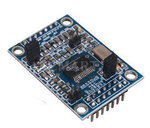Felis_Silvestris
Junior Member level 2
- Joined
- Dec 27, 2007
- Messages
- 23
- Helped
- 4
- Reputation
- 8
- Reaction score
- 4
- Trophy points
- 1,283
- Location
- San Jose, CA
- Activity points
- 1,517
I've dabbled a bit with microprocessors and even taught an online course in microprocessor interfacing (which is concerned more with peripherals than coding). However, I do not have any formal training or on the job training (or at home hobbyist training) in microprocessors such as the PIC or HC12. I have written limited code for both in C and assembly.
What I wish to accomplish is to build a robust function generator, but before I begin coding like a madman I would first like to find an architecture.
For now, I'm looking for
On my own I've considered two architectures (see attached jpg files). Architecture1 uses a function generator type IC that normally interfaces with a microprocessor leaving the microprocessor free to handle the user interface. Architecture2 uses a dedicated microprocessor for waveform generation and a dedicated microprocessor for the user interface.
My concern is producing a very stable waveform robust enough to run like a free running oscillator that has been locked to a PLL and immune user interface interact (other than setting waveform parameters).
My questions are
Does a function generator IC chip designed for uP interfacing (say, via SPI) already exist with its own oscillators and whatnot?
If not then what is a good architecture? My current thoughts are to use two microcontrollers one for waveform generation and the other for controlling the waveform parameters.
Any comments would be much appreciated!


What I wish to accomplish is to build a robust function generator, but before I begin coding like a madman I would first like to find an architecture.
For now, I'm looking for
- Frequency Range: mHz ~ 100kHz
- Stable Waveform (glitch free during normal operation)
- Square Wave is fine – but need accurate duty cycle settings.
- The waveform output doesn’t have to be locked to a PLL – but that type of stability would be preferred.
On my own I've considered two architectures (see attached jpg files). Architecture1 uses a function generator type IC that normally interfaces with a microprocessor leaving the microprocessor free to handle the user interface. Architecture2 uses a dedicated microprocessor for waveform generation and a dedicated microprocessor for the user interface.
My concern is producing a very stable waveform robust enough to run like a free running oscillator that has been locked to a PLL and immune user interface interact (other than setting waveform parameters).
My questions are
Does a function generator IC chip designed for uP interfacing (say, via SPI) already exist with its own oscillators and whatnot?
If not then what is a good architecture? My current thoughts are to use two microcontrollers one for waveform generation and the other for controlling the waveform parameters.
Any comments would be much appreciated!


